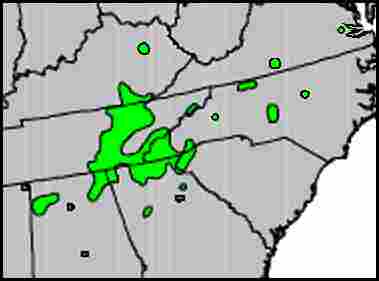Mountain Camellia
(Stewartia ovata)
The Mountain Camellia is a small rare tree native to the southern Appalachian region. It is distantly related to the evergreen camellias of Asia, and resembles them in some ways, but isn't evergreen. By going dormant in the fall, it can better survive the cold American winters.
The plant is also called Mountain Stewartia and Summer Dogwood. It is most common at low to mid elevations of the Great Smoky Mountains and on the Tennessee section of the Cumberland Plateau. Some isolated populations are also found in other areas, including small stands near Williamsburg, Virginia, and in northern Mississippi.
The species blooms later than most native plants, in early to mid-summer. Its beautiful camellia-like blossoms, about 3 inches wide, have waxy white petals and yellowish stamens. There is also an unusual form called stewartia ovata grandiflora which has larger blossoms and purple stamens. This form, sometimes called Showy Stewartia, is reportedly most common in the stand of trees growing near Williamsburg, but it has also been observed in other areas.
Wild specimens are usually less than 20 feet tall and often shrublike. They grow in the forest understory or at the edges of openings along streams. The leaves are oval-shaped, and turn orange, red, or gold before dropping in autumn. Woody seed capsules, about 1 inch long, can hang on the tree into the winter.
As a species, Stewartia ovata appears to be quite variable. Horticulturist Polly Hill planted seeds collected from specimens of the grandiflora form and found some notable differences among the resulting plants. Three of the observed forms were given names:
"Red Rose" (red stamens and yellow anthers)
"Royal Purple" (purple stamens and yellow anthers)
"Satin White" (white stamens and yellow anthers)
The blossom shown on this page, with purple stamens and orange anthers, is a grandiflora form. The photograph was taken in the Great Smoky Mountains National Park.
According to some authorities, the correct scientific name for this species is Stuartia ovata, but the older name Stewartia ovata is still in common usage.
Mountain Camellia can be difficult to obtain and difficult to grow. But if you succeed with it, you will have a very rare and beautiful plant.
Other Information
Scientific Names: Stewartia ovata, Stuartia ovata
Common Names: Mountain Camellia, Mountain Stewartia, Summer Dogwood
Plant Type: Small deciduous tree
Height: 15 to 20 feet
Cultivation Zones: 5 - 8
Native Habitat: Understory of hardwood forests, often near streams. Usually below 2500 feet.
Native Range: Scattered areas in the central and southern U.S.. See distribution map below.
Distribution Map

Range Map Source: U.S. Forest Service. (See General Note C)
Conservation Status: NatureServe lists Stewartia ovata as Imperiled in North Carolina, South Carolina, and Virginia; Critically Imperiled in Mississippi; Imperiled or Vulnerable in Alabama; and possibly Vulnerable in Georgia and Kentucky.
Cultivation: Mountain Stewartia can tolerate fairly heavy shade, but will grow faster and bloom more profusely if it receives at least a few hours of direct sunlight. It can take full sun in cooler climates, but partial or dappled shade might be best in the South. Try to give it a moist humus-rich soil with good drainage, and keep young trees well-watered, especially in hot climates or sunny exposures. Droughts can cause early leaf drop. Seeds require about 5 months warm stratification followed by about 3 months of cold stratification. Go to Cultivation and Seeds for more information.
Note: Some attempts to grow this plant have failed. It is apparently very intolerant of the wrong soil conditions, especially poor drainage. You might improve its chances of survival by planting it in specially-prepared soil on an artificial mound or other raised area.
Related Species: A similar native species, Stewartia malacodendron, is found in scattered locations from Virginia to Texas, mostly at low elevations near the coast. Known as Silky Camellia or Virginia Stewartia, it has four-inch white blossoms with purple stamens and blue anthers. It is an attractive plant, but isn't very cold-hardy, and might not survive north of Zone 7.
The only other stewartia species are native to Asia. More distant relatives include Franklinia and various camellias.
Plant Sources: Stewartia ovata can be difficult to find. Possible sources include Meadowbrook Nurseries and GroWild, which have occasionally sold it in the past. You can also try a web search. Note that a selection called "Scarlet Sentinel" is a hybrid with another stewartia species.
If you can't get a plant, you might try to grow this species from seed. This will take time, because the seeds normally require several months of both warm and cold exposures. If planted in the fall, they usually won't germinate until the second spring. Possible sources of seeds include F. W. Schumacher Company and Sheffields Seeds. (Go to Seeds for more information.)
For links to the mentioned suppliers, go to Sources of Plants.
|

